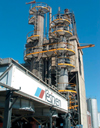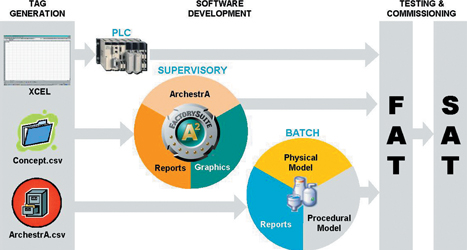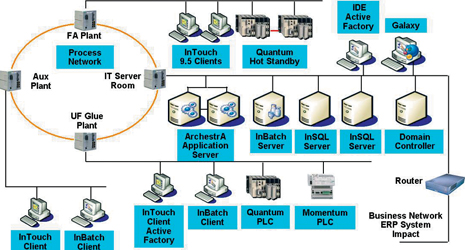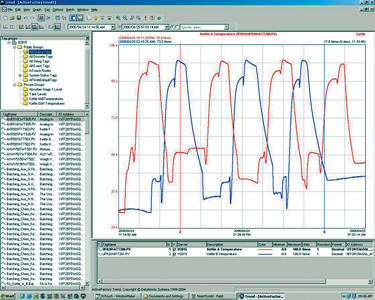

With its eyes firmly set on being one of the leading suppliers of formaldehyde and urea formaldehyde resins in southern Africa, Resinkem was faced with the dilemma of either extending the life of its ageing formaldehyde plant or building a new one. Feasibility studies showed that the first option was preferable provided that an aggressive modernisation programme was started.
With its eyes firmly set on being one of the leading suppliers of formaldehyde and urea formaldehyde resins in southern Africa, Resinkem was faced with the dilemma of either extending the life of its ageing formaldehyde plant or building a new one. Feasibility studies showed that the first option was preferable provided that an aggressive modernisation programme was started.
Background
Resinkem's Umbogintwini site consists of two plants - one producing formaldehyde where methanol is converted over a silver catalyst to create formaldehyde while the second plant manufactures formaldehyde resins for the chipboard industry.
Before the start of this project, the formaldehyde plant was judged to be at the end of its life, mostly because the pneumatic control system was obsolete. Although building a new formaldehyde plant was not feasible, a complete mechanical audit revealed that the existing plant's life could be extended by another 13 years if a new control system was put in place.
Another hurdle to overcome was the fragmentation of the plant's diverse systems. Various plant expansions over the last 10 years had left the glue plant with fragmented control and some of the plant additions were not connected to the PLC or batch engine.
The initiative that would revive the various plants such that Resinkem could achieve its business goal was aptly called Project Phoenix. The scope of the project included the complete replacement of the instrumentation control system with electronic instrumentation.
The project was implemented in three phases starting in 2004 with the formaldehyde plant control system upgrade. Then came the remodelling and re-engineering of the glue plant control system. This was followed by the phenolic resin project, which is currently being commissioned.
Project goals
The main project goal was to improve the formaldehyde plant efficiency by 0,5% in order to ensure that the product met specifications. The new control system had to deliver a stable, sustainable and scalable control platform that would cope with the future expansion of Resinkem's production facilities. Other goals focused on continually optimising production parameters and production consistency:
* Implement new software standards using S88.
* Ensure a stable and sustainable platform.
* Ensure process optimisation/consistency.
* Reduce downtime.
* Improve production flexibility.
* Improve reporting facilities.
* Improve product traceability.
* Minimal downtime during live changeover to the new system.
* Knowledge transfer and skills development to make Resinkem as independent as possible.
* Simple to maintain (ease of ownership).
Since both the formaldehyde and formaldehyde resin plants were continuous manufacturing facilities, neither could be shut down for a changeover, so most of the commissioning and changeovers had to be completed during full production. Critical items were left for times when the plant was shut down to change the catalyst.
Solution selection
Resinkem chose system integrator Convenient Software Solutions (CSS) to implement the three phases of Project Phoenix. CSS, in turn, selected Wonderware because of its completeness of industrial automation solutions which would not only satisfy current needs but would also allow seamless integration of future applications while providing for growth.
Resinkem had been using Wonderware's InTouch SCADA solution since 1989 and the excellent results and service they experienced was also a key factor in the choice of Wonderware. Wonderware's InBatch was selected as the batch engine on the glue plant because of its powerful SQL reporting tools and the fact that it is now being consolidated more and more within the ArchestrA framework (ie, batch objects as ArchestrA extensions).
"ArchestrA's flexibility and scalability was a good fit for Resinkem's business growth strategies," says Pieter Venter of CSS. "As Resinkem's needs increase in the future, it will be possible to add application servers and to continue working in a single galaxy with virtually unlimited tags. We at CSS have developed a set of software standards and this was made available to Resinkem thereby saving it engineering costs and time."
With multiple manufacturing plant areas on site, ArchestrA now provides a central point of configuration, which makes maintaining the system easier.
Solution implementation
The formaldehyde plant is a Class 1 Div 1 classified area and most of the work had to be completed during normal production. Critical work, such as the shutdown trip system changeover, could only be completed during plant stoppages when production was changing the silver catalyst.
"The implementation methodology that we followed was to start with the base documentation," says Venter. "This consisted of the software standards, P&IDs and the functional specification which included the process description in narrative format and the reporting requirements. From there we did the detailed design and produced what we called the rollout documentation. This included the control module listing, plant capabilities addressing structure and phase summary lists.
"Next we used the information contained in the rollout documentation to create our PLC and ArchestrA databases. We then started the software development phase, which consisted mainly of three components. PLC, supervisory and the InBatch development (see Figure 1). Following this we completed factory acceptance testing and then proceeded with commissioning."

The PLC integration is based on a complete hot standby configuration from external supply to PLC hardware. The software was structured into groups like control module types, plant areas and material phases.
The formaldehyde plant's most critical devices are its blower, steam and vent control. In the event of a power failure or even a power dip, these would trip the plant with the result that, most of the time, the silver catalyst had to be replaced. This normally took the plant out of production for at least a day and a half. To overcome this, the new system continually monitors the condition of these critical devices and stores their status values. If there is a power dip of less than 500 ms, they are automatically restarted and their status values are restored to what they were prior to the dip. The result is that the plant now recovers without tripping in full.
"For the supervisory portion of the work we made some changes to our ArchestrA object standards before we used the tag generator to create the database," says Venter. "On importing, it created all the instances of the objects together with their tags and put them into the correct structure according to the S88 areas we had defined. Redundancy was a prerequisite for the project at all control levels and we used the Application Servers in hot standby mode. All that was required to do this was the ticking of a couple of boxes - a far simpler exercise than a few years ago."
For the InTouch HMI graphics, CSS decided to use a flat 2D representation, which the operators preferred over their previous 3D images. For all the plant equipment, CSS used instances of smart symbols, which combined the parameter popup screens with the graphics. All plant I/O and control parameters were logged to IndustrialSQL Server, which enabled the extensive use of Active factory as a diagnostic tool for plant optimisation and for minimising plant downtime by preventing recurring trips.

For the InBatch system in the glue plant, CSS set up the physical model by identifying and configuring all the devices that can contain or process material (eg reactor tanks and mixers). Then came the setting up of the process phases that interact with these devices (eg, heating, cooling, mixing, etc). This was followed by configuring the transfer phases to batch product during the movement of material via an integrator such as a Coriolis meter. Segments had to be defined where the integrator or measurement device is shared by more than one unit. Along with this, the connections for all units and segments were configured as this links the whole plant together.
"A major advantage is that InBatch then does automatic arbitration of plant equipment once these segments and connections have been defined," says Venter. "Another excellent feature of InBatch is the fact that all the reporting is done for you - reports such as a Complete Batch Journal and Material Usage."
For the procedural model, CSS created recipes, which included all the material quantities to be used as well as the units’ procedures. Also included were all the detailed operations and phases required to complete theses procedures.
"Looking at the project time allocation, we found that we reduced the coding time dramatically by investing more time and effort in getting the URS and CFS correct with as much detail as possible," explains Venter. "FAT testing and commissioning still took up a significant portion of the project time since errors could not be tolerated during changeover which had to be mostly completed during full production."

Benefits realised and goals achieved
* Improved formaldehyde plant efficiency - since plant parameters can now be controlled individually, it has been possible to optimise efficiency with the result that there has been an increase of 3,2% in methanol and formaldehyde production as well as an annual saving of R1,6 million.
* Prolonged catalyst life.
* Automatic re-start after a power trip.
* Power dip ride through savings in excess of R450k.
* 50% reduction in start-up time.
* Process consistency and optimisation.
* Improved reporting - this allows for sound business decisions based on actual fact rather than guesswork.
* Formaldehyde plant is running solo.
Project Phoenix was completed on schedule and a new phenol formaldehyde plant is currently in the commissioning phase. Future expansion is currently at board level for approval and this will require more application servers as well as an extension to the InBatch Server and all its associated clients.
The improved plant efficiency and process control has established Resinkem as the leading supplier of formaldehyde and urea-formaldehyde resins in southern Africa.
For more information contact Justin Tweedie at Wonderware Southern Africa (a member of the EOH Group of Companies), 0861 WONDER (0861 966 337), [email protected] or [email protected]

© Technews Publishing (Pty) Ltd | All Rights Reserved